Home
> Chords
/ Progressions
>
Diminished Chords
There's a lot of confusion around how diminished chords work in music. I often get asked the question of "when to use them" in a chord progression.
As with music in general, there are no hard and fast rules (except "if it sounds good, play it!"), but I'll take you through some of the tried and tested functions diminished chords can serve in your music.
Even if you were just looking for a chord chart (which is further down the page), read through the whole lesson, split over a few days, as it will prove very rewarding as far as developing your improvisation and songwriting skills.
There are 3 main types of diminished chord, as shown in the table below.
Note that if you see the ° symbol after the chord letter (e.g. C°), it means "diminished". When typing, some people just use "o" as the proper symbol requires digging out the character map!
As you can see, there's a common occurence of the root (1), b3 (flat/minor 3rd) and b5 (flat 5th) in the three types. These are the most important tones in any diminished chord or scale. The flat 5th in relation to a minor 3rd is what gives it that unstable quality.
So, a diminished triad can simply be thought of as a minor chord with a flat 5th.
A half diminished chord is the above diminished triad with an added flat 7th. This chord is also sometimes written as m7b5 (minor 7 flat 5) e.g. Cm7b5.
A diminished seventh chord is a diminished triad with an added diminished 7th. That's another way of saying "double flat 7th". So the only difference between a dim7 and m7b5 chord is the 7th is flattened another semitone in dim7 chords.
First, just make clear in your mind these distinctions as each one has a different sound and function which we'll look at shortly.
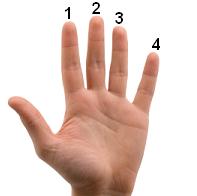 To
help you
play along throughout this lesson, here are the most common
diminished guitar chord forms used in chord progressions with their
fingerings.
To
help you
play along throughout this lesson, here are the most common
diminished guitar chord forms used in chord progressions with their
fingerings.
 Download the printable chord chart
(PDF)
Download the printable chord chart
(PDF)
Note that I haven't included diminished triads, because these are most commonly extended to half diminished or diminished 7th. You can see how the triad exists in both these types.
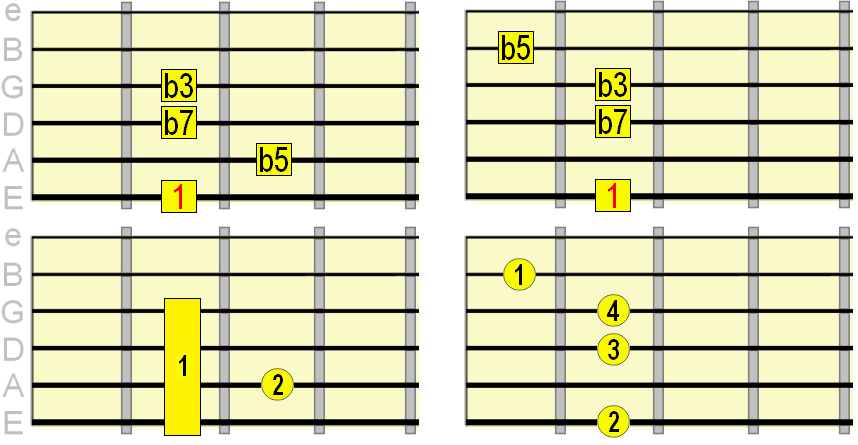
A string shape D string shape
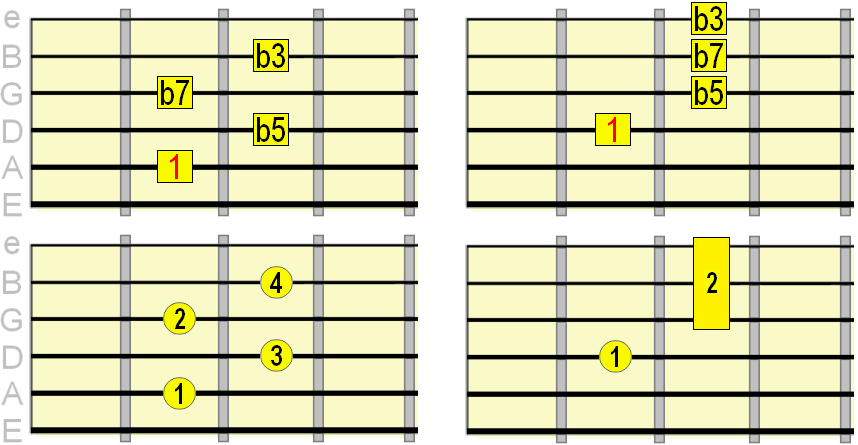
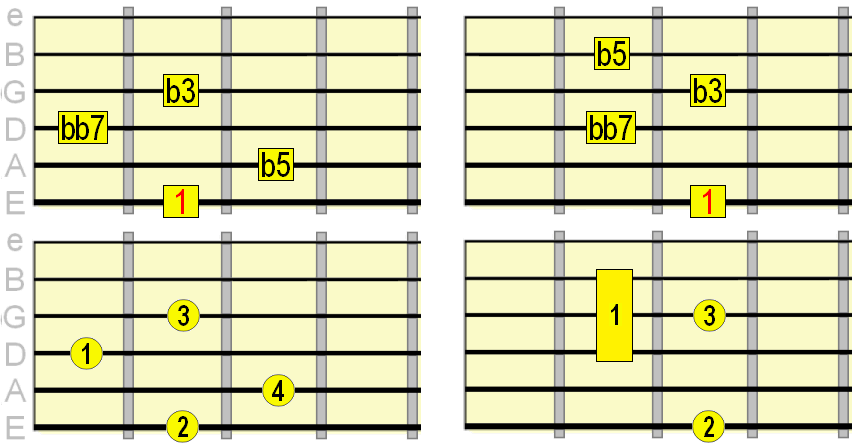
A string shape D string shape
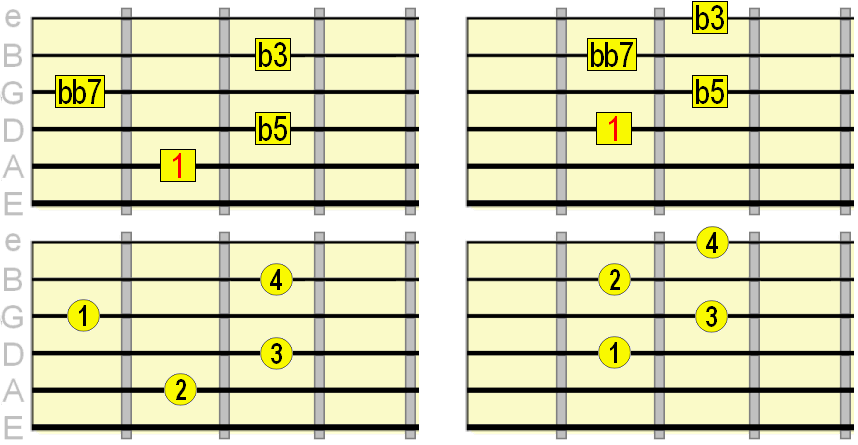
So, whenever there is an occurence of a diminished chord then you should try both m7b5 (half diminished) or dim7 and go with the one that sounds best to you.
Let's look at some typical uses of the chord.
It's called a "leading tone" or "leading chord" because it naturally resolves or "leads" to the tonic. You can hear an example here. See the table below for a breakdown...
That's just a few examples. You should be able to see this same leading tone chord - tonic relationship no matter what key you're in.
In minor keys, and especially minor keys based around harmonic minor, a diminished 7th chord is the natural leading tone chord (click to hear example).
Cmaj7 - Dm7 - Em7b5 - A7 - Dm7 - G7 - Cmaj7 - click to hear
It's also used in jazz to extend the ii V I (2 5 1) turnaround as follows...
Dm7 - G7 - Em7b5 - Aaug7 - Dm7 - G7 - Cmaj7 - click to hear
You can hear how the tension in that half diminished iii chord is transferred to the augmented 7th chord before the natural ii V I resolution.
Minor key: Am - Bm7b5 - E7 - Am - click to hear
Major key: C - Dm7b5 - G7 - C - click to hear
We can also use a dim7 chord on the same ii chord root in place of the V chord...
Am - Bm7b5 - Bdim7 - Am - click to hear
E major - Edim7 - E major - click to hear
You could also do the same with a minor tonic.
What this does is destabilise the tonic for added interest.
For example, the major diatonic scale is as follows...

We can literally plug those whole step (W) gaps between the 1 and 2 chords, 2 and 3 chords, 4 and 5 chords, and 5 and 6 chords with a dim7. We can now visualize the scale as follows...

If we were playing in the key of C, some examples of the above technique would be as follows...
C - Em - F - F#dim7 - C - G - Fm - C - click to hear
C - C#dim7 - Dm7 - G7 - C - click to hear
C - Ebdim7 - Dm7 - G - C - click to hear
C - G - Abdim7 - Am - F - G - C - click to hear
Those are pretty simple progressions, but using that diminished 7th "plugging" technique adds some spice and unpredictability.
You can also do the same with minor key progressions or any progression that uses whole steps.
1 > minor 3rd > b3 > minor 3rd > b5 > minor 3rd > bb7 > minor 3rd > 1
This gives the chord what is known in music as symmetry.
It means we can apply a pretty cool trick when playing the chord in a progression.
1) Start by playing a Cdim7 chord (or any root).
2) Keep that same chord form and move it up 3 frets (that's the equivalent of a minor 3rd interval). So Cdim7 would move to Ebdim7.
3) From that new position, move another 3 frets, again keeping the same dim7 form. From Ebdim7 we'd end up at F#dim7.
Here's what we get (click to hear)...

Tip: Don't just move in minor 3rds using one root string. Try moving in minor 3rds from the E to A string and A to D strings, using the chord shapes you learned earlier.
Because of the symmetry of the dim7 intervals, moving in minor 3rds like this produces exactly the same chord, but each new position is a different inversion of that original dim7 chord.
Practically, that means whenever we choose to play a dim7 chord, using any of the functions covered in this lesson, we can also play any of its related positions based on its minor 3rd intervals.
So let's take a progression from earlier using the whole step plugging technique...
C - C#dim7 - Dm7 - G7 - C - click to hear
We could also play...
C - Edim7 - Dm7 - G7 - C - click to hear
Because of this minor 3rd symmetry, Edim7 is actually the same as C#dim7, its intervals are just inverted, changing its voicing.
You can use this method to create more elaborate chord progressions, such as the following...
Click to hear
All I'm doing there is moving in minor 3rd intervals (up or down the fretboard) whenever I use a diminished seventh chord. It was just an example, so don't overuse it!
I hope this lesson has given you some fresh ideas for your songwriting. Keep experimenting with using diminished guitar chords in different ways.
Share your thoughts...
Have any questions, thoughts or ideas about this lesson? Let us know using the comments form below.
Diminished Guitar Chords in Theory & Practice
This lesson will explain the theory behind diminished guitar chords and their function.There's a lot of confusion around how diminished chords work in music. I often get asked the question of "when to use them" in a chord progression.
As with music in general, there are no hard and fast rules (except "if it sounds good, play it!"), but I'll take you through some of the tried and tested functions diminished chords can serve in your music.
Even if you were just looking for a chord chart (which is further down the page), read through the whole lesson, split over a few days, as it will prove very rewarding as far as developing your improvisation and songwriting skills.
Diminished chord theory - how to construct them
Diminished chords ("diminished" referring to the diminished 5th in the chord) have an unstable sound. They create an air of tension and unresolve (hear the examples below) which is what makes them wonderfully intriguing chords to use in your music.There are 3 main types of diminished chord, as shown in the table below.
Note that if you see the ° symbol after the chord letter (e.g. C°), it means "diminished". When typing, some people just use "o" as the proper symbol requires digging out the character map!
| Full chord name | Abbreviations | Intervals | Hear it |
| Diminished triad | dim
(Cdim, Edim) ° (C°, E°) |
1 b3 b5 | click here |
| Half diminished chord | m7b5 (Cm7b5, Em7b5) | 1 b3 b5 b7 | click here |
| Diminished seventh chord | dim7
(Cdim7, Edim7) °7 (C°7, E°7) |
1 b3 b5 bb7 | click here |
As you can see, there's a common occurence of the root (1), b3 (flat/minor 3rd) and b5 (flat 5th) in the three types. These are the most important tones in any diminished chord or scale. The flat 5th in relation to a minor 3rd is what gives it that unstable quality.
So, a diminished triad can simply be thought of as a minor chord with a flat 5th.
A half diminished chord is the above diminished triad with an added flat 7th. This chord is also sometimes written as m7b5 (minor 7 flat 5) e.g. Cm7b5.
A diminished seventh chord is a diminished triad with an added diminished 7th. That's another way of saying "double flat 7th". So the only difference between a dim7 and m7b5 chord is the 7th is flattened another semitone in dim7 chords.
First, just make clear in your mind these distinctions as each one has a different sound and function which we'll look at shortly.
Diminished guitar chords chart - how to play them
 To
help you
play along throughout this lesson, here are the most common
diminished guitar chord forms used in chord progressions with their
fingerings.
To
help you
play along throughout this lesson, here are the most common
diminished guitar chord forms used in chord progressions with their
fingerings. Download the printable chord chart
(PDF)
Download the printable chord chart
(PDF)Note that I haven't included diminished triads, because these are most commonly extended to half diminished or diminished 7th. You can see how the triad exists in both these types.
Half diminished chord chart
E string shapes
A string shape D string shape

Diminished seventh chord chart
E string shapes
A string shape D string shape

Diminished chords function - when to use them
As mentioned earlier, occurences of the diminished triad are often extended to half diminished or diminished 7th chords, because they sound more... interesting. Essentially, you're playing the diminished triad in both those variations anyway, so they're just a meatier, more colourful version of the triad.So, whenever there is an occurence of a diminished chord then you should try both m7b5 (half diminished) or dim7 and go with the one that sounds best to you.
Let's look at some typical uses of the chord.
Leading tone (vii) diminished chord
In major keys, a half diminished chord naturally occurs on the 7th degree (called the leading tone or vii). In plain English that means whatever the major tonic (I) chord is, the diminished chord naturally sits one semitone/fret down from that.It's called a "leading tone" or "leading chord" because it naturally resolves or "leads" to the tonic. You can hear an example here. See the table below for a breakdown...
| Key / Tonic Chord | Lead tone chord | Examples |
| C major | Bdim | F / Bdim / C Dm / Bdim / C Am / Bdim / C |
| C# major | Cdim | F# / Cdim / C# Ebm / Cdim / C# Bbm / Cdim / C# |
| D major | C#dim | G /
C#dim / D Em / C#dim / D Bm / C#dim / D |
That's just a few examples. You should be able to see this same leading tone chord - tonic relationship no matter what key you're in.
In minor keys, and especially minor keys based around harmonic minor, a diminished 7th chord is the natural leading tone chord (click to hear example).
| Key / Tonic Chord | Lead tone chord | Examples |
| C minor | Bdim7 | F / Bdim7 / Cm |
| C# minor | Cdim7 | F# / Cdim7 /
C#m |
| D minor | C#dim7 | G /
C#dim7 / Dm |
Half diminished iii chord
In major key progressions, the iii chord (naturally minor) is sometimes replaced with a half diminished iii. You'll hear this most commonly used in jazz. For example...Cmaj7 - Dm7 - Em7b5 - A7 - Dm7 - G7 - Cmaj7 - click to hear
It's also used in jazz to extend the ii V I (2 5 1) turnaround as follows...
Dm7 - G7 - Em7b5 - Aaug7 - Dm7 - G7 - Cmaj7 - click to hear
You can hear how the tension in that half diminished iii chord is transferred to the augmented 7th chord before the natural ii V I resolution.
Half diminished ii chord
Half diminished chords are also often used as the ii chord of major and minor key progressions before the V chord. Take a listen...Minor key: Am - Bm7b5 - E7 - Am - click to hear
Major key: C - Dm7b5 - G7 - C - click to hear
We can also use a dim7 chord on the same ii chord root in place of the V chord...
Am - Bm7b5 - Bdim7 - Am - click to hear
Parallel diminished 7th chord
A diminished 7th chord can resolve to a chord with the same root (known as a parallel chord change). For example, if the tonic was E major...E major - Edim7 - E major - click to hear
You could also do the same with a minor tonic.
What this does is destabilise the tonic for added interest.
Plugging whole step interval gaps
Essentially, you can fill any whole step interval between two chords in a scale with a diminished 7th chord.For example, the major diatonic scale is as follows...

We can literally plug those whole step (W) gaps between the 1 and 2 chords, 2 and 3 chords, 4 and 5 chords, and 5 and 6 chords with a dim7. We can now visualize the scale as follows...

If we were playing in the key of C, some examples of the above technique would be as follows...
C - Em - F - F#dim7 - C - G - Fm - C - click to hear
C - C#dim7 - Dm7 - G7 - C - click to hear
C - Ebdim7 - Dm7 - G - C - click to hear
C - G - Abdim7 - Am - F - G - C - click to hear
Those are pretty simple progressions, but using that diminished 7th "plugging" technique adds some spice and unpredictability.
You can also do the same with minor key progressions or any progression that uses whole steps.
The symmetry of diminished seventh chords
If you look at the intervals of a diminished seventh chord, you'll notice that each one is separated by a minor 3rd. In other words, there is equal spacing between each note of a dim7 chord.1 > minor 3rd > b3 > minor 3rd > b5 > minor 3rd > bb7 > minor 3rd > 1
This gives the chord what is known in music as symmetry.
It means we can apply a pretty cool trick when playing the chord in a progression.
1) Start by playing a Cdim7 chord (or any root).
2) Keep that same chord form and move it up 3 frets (that's the equivalent of a minor 3rd interval). So Cdim7 would move to Ebdim7.
3) From that new position, move another 3 frets, again keeping the same dim7 form. From Ebdim7 we'd end up at F#dim7.
Here's what we get (click to hear)...

Tip: Don't just move in minor 3rds using one root string. Try moving in minor 3rds from the E to A string and A to D strings, using the chord shapes you learned earlier.
Because of the symmetry of the dim7 intervals, moving in minor 3rds like this produces exactly the same chord, but each new position is a different inversion of that original dim7 chord.
Practically, that means whenever we choose to play a dim7 chord, using any of the functions covered in this lesson, we can also play any of its related positions based on its minor 3rd intervals.
So let's take a progression from earlier using the whole step plugging technique...
C - C#dim7 - Dm7 - G7 - C - click to hear
We could also play...
C - Edim7 - Dm7 - G7 - C - click to hear
Because of this minor 3rd symmetry, Edim7 is actually the same as C#dim7, its intervals are just inverted, changing its voicing.
You can use this method to create more elaborate chord progressions, such as the following...
Click to hear
All I'm doing there is moving in minor 3rd intervals (up or down the fretboard) whenever I use a diminished seventh chord. It was just an example, so don't overuse it!
I hope this lesson has given you some fresh ideas for your songwriting. Keep experimenting with using diminished guitar chords in different ways.
| Was this
helpful? Please support this site. I really appreciate it! |
Stay updated
and learn more Sign up to the newsletter for updates and grab your free Uncommon Chords book |
Share your thoughts...
Have any questions, thoughts or ideas about this lesson? Let us know using the comments form below.
Related Lesson
Augmented Guitar Chords








